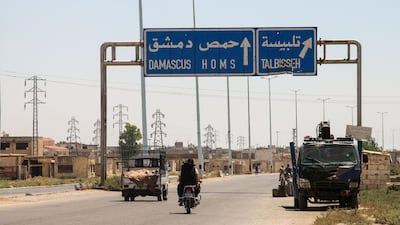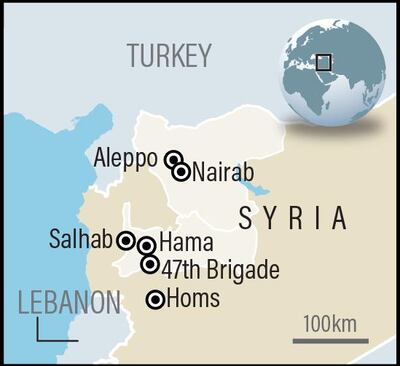Russian and Syrian government jets bombed two hospitals in the opposition held town of Al Rastan in two separate attacks launched Sunday and Monday against the last rebel held stronghold in the northern part of Syria’s central Homs province.
The attacks, which local doctors said killed at least six civilians and injured another fifty, comes after a pledge by the government of President Bashar Al Assad to retake the countryside north of Syria’s third largest city Homs, where the last rebel strongholds were defeated last May.
The conflict in central Syria further escalated over the weekend as missiles launched by unidentified assailants hit the Syrian army 47th Brigade military base 20 kilometres north of the rebel stronghold in the Salhab area, west of Hama city, and targets close to the Nairab military airport near Aleppo.
The Assad government's official news agency SANA reported Sunday that a number of military sites in the countryside of Hama and Aleppo provinces were hit in a multi-pronged rocket attack at around 10:30pm local time.
“It was definitely Israel,” said Dyaa Kadoor, a 30-year-old captain in the Free Syrian Army in Houla, an agricultural town 30 kilometres northwest of Homs. “Our missiles can’t be so accurate.”
Israel hasn't publicly acknowledged the attacks, but Israeli officials told Haaretz newspaper that "if Iran attacks Israel from Syria, either itself or through its proxy Hezbollah, Jerusalem will not hold back and will respond forcefully, targeting Iranian soil."
_______________
Read more:
Syrian army says ‘enemy’ rocket attacks strike at military bases
Mostly Iranians killed in Syria strikes, monitor says
Syria regime and rebels agree evacuation deal in southern Damascus
_______________
Damascus forewarned of the current escalation last Tuesday when Ali Haidar, the Syrian national reconciliation minister charged with implementing evacuation deals, said the government was dropping leaflets and communicating with rebels in the opposition-held towns of Rastan, Talbiseh and Houla.
The Syrian army and its allies — Russians with their air power and foreign Shiite fighters from Lebanon, Iraq and Iran — have used siege and bombardment tactics to force rebel groups into submission, sometimes negotiating relocation deals to bus opposition fighters and their families to northern Syria, mostly in Idlib province to the north of Homs.
“Armed groups wait to feel the seriousness and determination of the state’s military action before they approach serious discussion of a reconciliation agreement,” Mr Haidar said.
The current wave of strikes by the Syrian air force and its Russian allies against the rebel-held towns of Rastan, Talbiseh and Houla started Wednesday and on Sunday they struck a field hospital in al Za’farana village.
“All of the injured are civilians, women and children,” said Kamal Bahbough, a doctor in Al Rastan. “We expect the number of dead to go up because so many of them have head wounds and severe neurological damage. We keep them on the respirators but the truth is they are hopeless.”
At 9am local time on Monday, Dr Bahbough sent out a text message: “Our hospital has been bombed. We are evacuating and taking the injured that we can to other places.”
Government forces and its Russian and Iranian allies were "using everything against us," he said. "Air strikes from jets, barrel bombs from helicopters and shelling us with long range mortars.”
Medical personnel on the ground say they are afraid that a chemical attack could be next.
_______________
Read more:
Syrian regime turns focus to Daraa as battle for last Damascus enclave goes underground
At least 43 killed in one of the deadliest attacks in Damascus
_______________
Rastan suffered a chemical attack in August 2015 that resulted in five deaths and multiple injuries. Dr Jamal Edeen, who manages a network of hospitals and clinics in the Homs countryside for the Syrian American Medical Society Foundation, says the area is not ready for another one.
“It’s never clear if they will use sarin or chlorine gases and we have only small quantities of atropine, no anti chemical clothes or equipment,” said Dr. Edeen. ” At some point I expect to evacuate my family.”
Roadblocks manned by a beefed-up presence of government troops appeared in rural Homs this week after gains by the Syrian army around Ghouta, the last large rebel outpost in the Damascus suburbs and the site of the most recent suspected chemical weapons attack by Assad’s forces.
“They are launching these raids on the northern Homs countryside to subjugate the liberated area and to cause a rift between civilians and rebels,” said Col. Fatih Hassoun, the leader of the Free Syrian Army’s Central Front.
Col. Hassoun said the Assad government and its allies had underestimated the remaining rebel strength. “This insistence of the fighters to withstand the assault has made the Russians ask for a negotiating round, and we will have one tomorrow.”
He continued: “The Russians will insist on the departure of fighters from the region and the fighters will insist on resistance. Things will escalate and civilians will pay the price because of the bombardment by both Russia and the regime.”


